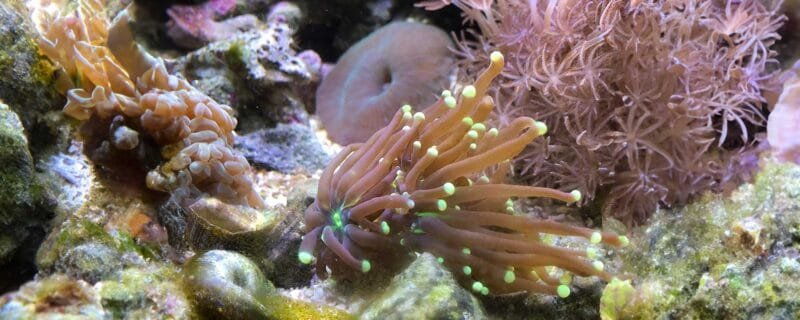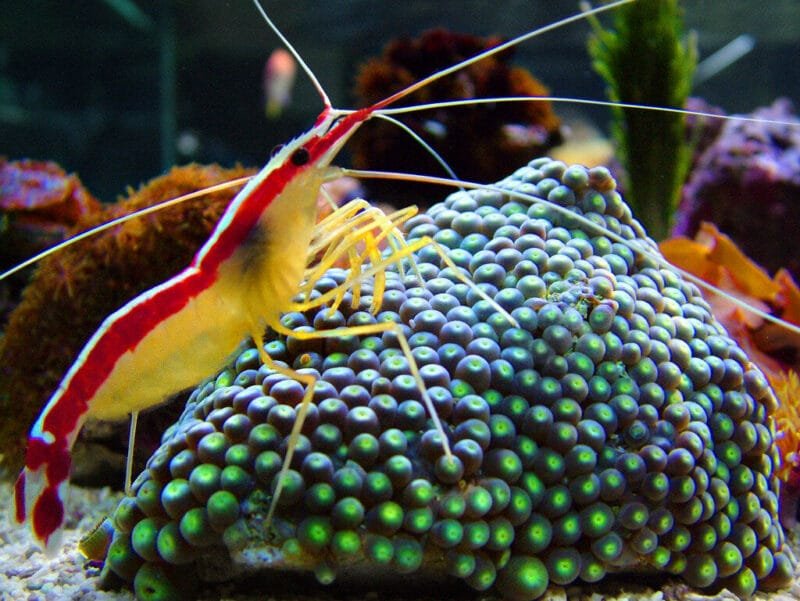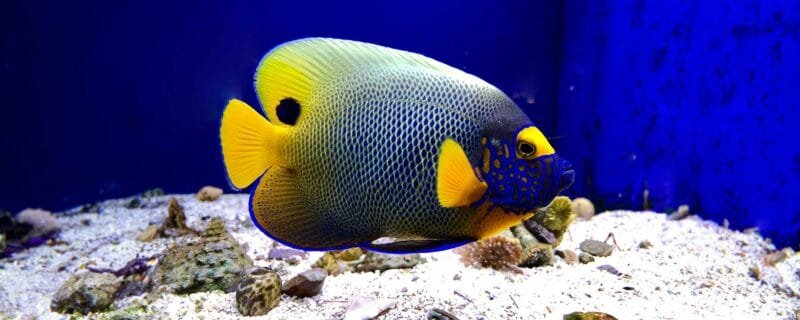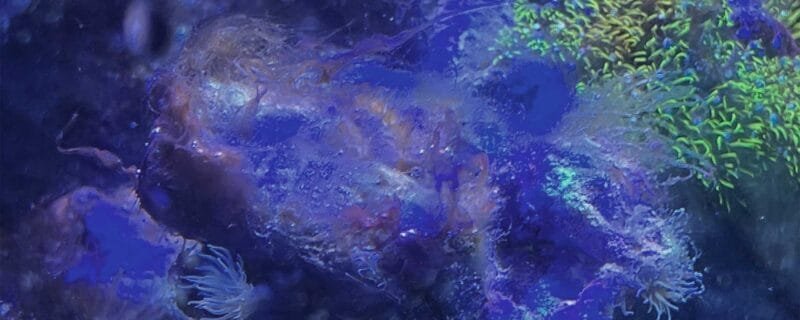The Sexy Shrimp, scientifically known as Thor amboinensis, is one of the most eye-catching and charismatic shrimp species found in the marine aquarium trade. Native to warm tropical waters, this tiny crustacean captivates aquarists with its brilliant coloration, distinctive swaying motion, and symbiotic behavior with corals and anemones. Despite its name, this shrimp’s charm comes from elegance, confidence, and constant movement — making it a true centerpiece for nano reef tanks.
Native Habitat
Thor amboinensis originates from the tropical Indo-Pacific region, including the Red Sea, East Africa, Indonesia, the Philippines, and the Great Barrier Reef. It typically inhabits shallow reef environments and is most commonly found living symbiotically with sea anemones and corals. Its natural association with these hosts provides it shelter and food, while it helps keep its host clean of debris.
In the wild, you’ll find groups of Sexy Shrimp nestled among the tentacles of anemones, constantly flicking their tails in a rhythmic “dance” that’s both charming and believed to be a form of communication.
Size and Appearance
Sexy Shrimp are diminutive in size, usually reaching about 2 cm (0.75 inches) in length when fully grown. Despite their tiny stature, they are incredibly colorful. Their bodies are translucent amber or orange with large, well-defined white spots bordered by dark lines. The tail is often accented with blue or violet hues.
Their name “Sexy Shrimp” comes from their characteristic posture — tail curled upward and constantly waving side to side — resembling a flirtatious dance that has made them an instant favorite among marine enthusiasts.
Diet and Feeding
In the wild, Thor amboinensis feeds on detritus, plankton, and the leftover bits of food from its anemone host. In captivity, they adapt easily to a variety of foods.
A balanced diet includes:
-
Finely chopped mysis shrimp or brine shrimp
-
Marine pellets and micro granules
-
Frozen plankton and cyclops
-
Occasional feeding of flake food for variety
They are opportunistic feeders, often scavenging around their coral or anemone host for leftover food particles. Feeding once or twice a day in small portions is sufficient.
Sexing
Sexing Thor amboinensis can be tricky due to their small size and subtle differences. Generally:
-
Females are slightly larger and have broader abdomens to carry eggs.
-
Males are smaller and slimmer.
Under close observation, a female carrying eggs will have a visible clutch under her abdomen, making it easier to distinguish.
Breeding
Breeding Sexy Shrimp in captivity is possible but requires stable water conditions and patience.
They are protandric hermaphrodites, meaning they can start life as males and later transition into females as they mature or as social dynamics demand.
Once paired, females carry bright green eggs beneath their tails for about 2 weeks before they hatch into free-swimming larvae. These larvae need specialized planktonic foods (like rotifers and baby brine shrimp) and can take several weeks to settle into juvenile shrimp.
Raising larvae to adulthood can be challenging due to their sensitivity and tiny size, but it is achievable in dedicated breeding setups.
Reef Safety and Compatibility
Sexy Shrimp are reef safe and ideal for nano reef tanks. They do not harm corals or fish, though they may occasionally pick at soft coral polyps if underfed. Their symbiotic relationship with small anemones like Mini Carpet Anemones (Stichodactyla tapetum) makes them a stunning natural display.
Tankmates That Get Along Well:
-
Clownfish (in larger systems)
-
Gobies and Blennies
-
Cleaner Shrimp (Lysmata amboinensis) and Peppermint Shrimp
-
Small Reef-Safe Snails
-
Firefish and Neon Gobies
Avoid housing them with:
-
Aggressive fish like Dottybacks, Wrasses, or Hawkfish
-
Larger crustaceans or predatory shrimp that might view them as food
Water Conditions
Sexy Shrimp thrive in stable, pristine reef conditions.
Ideal Parameters:
| Parameter | Recommended Range |
|---|---|
| Temperature | 24–27°C (75–81°F) |
| pH | 8.0–8.4 |
| Salinity | 1.023–1.026 (Specific Gravity) |
| Ammonia/Nitrite | 0 ppm |
| Nitrate | < 10 ppm |
| Flow | Gentle to moderate |
| Tank Size | Minimum 10 gallons |
A mature reef tank with stable parameters is best. Since they are small, they don’t require large systems, but they do benefit from established biological filtration and regular water changes.
Ease of Care
Ease of Care: Moderate
Sexy Shrimp are relatively hardy once acclimated, but they are sensitive to fluctuations in salinity, temperature, and nitrate levels. Due to their small size and vulnerability, they should only be introduced into stable, mature tanks.
They are peaceful and active throughout the day, adding charm and liveliness to small aquascapes. Regular feeding, stable conditions, and gentle water flow will keep them healthy and active.
Species Variations
While Thor amboinensis is the most recognized species, variations exist within the Thor genus. Subtle differences in coloration, pattern, and host preference distinguish them. Some have more pronounced white spots or slightly altered tail colors, influenced by location and habitat.
Albino Version
Albino Sexy Shrimp are exceedingly rare in captivity. These individuals exhibit a pale, translucent coloration with reduced pigmentation but retain the same behavioral patterns. While not common in the trade, occasional morphs with lighter patterns or reduced spots appear, prized by collectors for their uniqueness.
Community Tank Compatibility
The Sexy Shrimp’s small size and gentle behavior make it perfect for peaceful community reef tanks. In nano reefs, they become the star attraction, often perching proudly on coral heads or waving from the tentacles of their chosen anemone.
They can be kept in small groups (3–5 individuals) as they are social and enjoy company. However, ensure ample space and hiding spots to prevent minor territorial disputes.
Interesting Facts
-
The “sexy dance” behavior is a form of communication and display, signaling confidence and possibly warding off competitors.
-
They can regrow lost limbs after molting if injured.
-
Their symbiosis with anemones mirrors that of clownfish — both species benefit from protection and food exchange.
FAQs About the Sexy Shrimp
1. Why do Sexy Shrimp dance?
Their rhythmic tail-flicking is thought to be a form of communication or a display of dominance and confidence. It may also help them maintain balance while living among the swaying tentacles of anemones.
2. Can Sexy Shrimp live without anemones?
Yes, they can live comfortably without anemones, especially if provided with soft coral or live rock for shelter. However, they naturally prefer anemones for protection and comfort.
3. Are Sexy Shrimp suitable for nano tanks?
Absolutely. Their small size, reef-safe behavior, and minimal space requirements make them perfect for nano reef aquariums of 10 gallons or larger.
Final Thoughts
The Sexy Shrimp (Thor amboinensis) is a gem among reef invertebrates — dazzling, interactive, and surprisingly easy to maintain once settled. With its playful dance, striking colors, and peaceful temperament, this shrimp brings charm and personality to any saltwater aquarium. Ideal for reef enthusiasts seeking movement and flair in a compact form, the Sexy Shrimp truly lives up to its name — beautiful, confident, and impossible to ignore.






